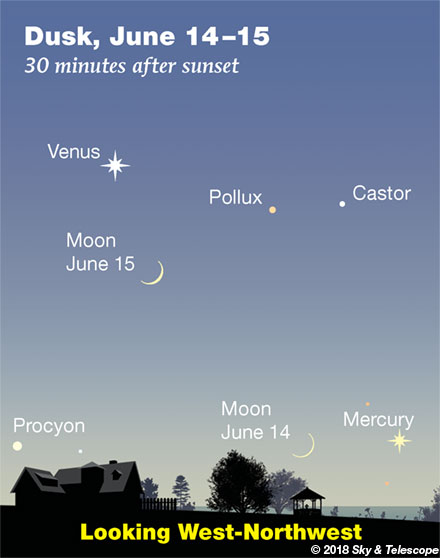
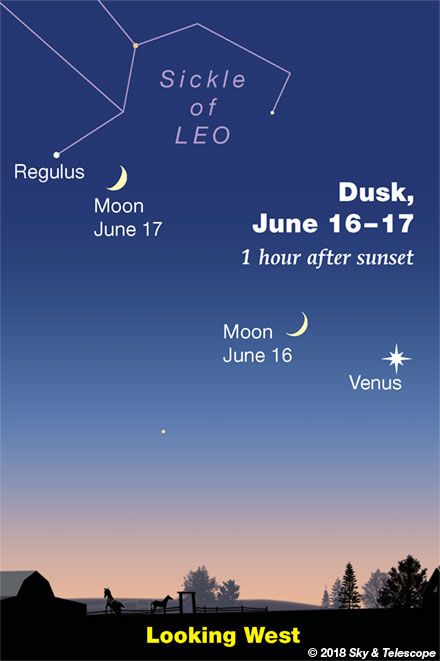
Friday, June 15
• As twilight fades after sunset, look very low in the west-northwest for the thin crescent Moon under Venus, as shown here.
• It's almost summer. But as twilight fades, look very low in the north-northwest for wintry Capella very out of season. The farther north you are, the higher it will appear. You may need binoculars. If you're as far north as Portland Oregon and Portland Maine, Capella is actually circumpolar.
Saturday, June 16
• Look west as twilight fades for Venus and the thin waxing crescent Moon, as shown below. They're about 8° apart at the times of twilight for North America. Higher to their upper left, look for much fainter Regulus coming out as twilight fades further.
Sunday, June 17
• The crescent Moon, far upper left of Venus, shines near Regulus tonight. Almost as bright as Regulus is orange Gamma Leonis (Algieba), higher above the Moon as shown here.
Monday, June 18
• Now Regulus shines to the Moon's lower right. Look for Denebola, Leo's tail tip, and Zosma, Leo's rump, above the Moon.
Tuesday, June 19
• With summer officially just two days away, the Summer Triangle stands high and proud in the east after dark. Its top star is bright Vega. Deneb is the brightest star to Vega's lower left (by 2 or 3 fists at arm's length). Look for Altair a greater distance to Vega's lower right.
If you have a dark sky, you'll see that the Milky Way passes under Vega through the Summer Triangle.
Wednesday, June 20
• Spot Vega high in the east and Arcturus high in the southwest. Draw a line from Vega to Arcturus. A third of the way along this line is the dim Keystone of Hercules. Two thirds of the way is the semicircle of Corona Borealis, the Northern Crown, with its one modestly bright jewel, Gemma or Alphecca.
Thursday, June 21
• The June solstice arrives at 6:07 a.m. EDT, marking the start of summer in the Northern Hemisphere and winter in the Southern Hemisphere. This is when the Sun is at its farthest north in the sky and begins its six-month return southward. It's the longest day of the year in the Northern Hemisphere, the shortest day in the Southern.
If you have a good view of the west-northwest horizon (from mid-northern latitudes), mark precisely where the Sun sets. In a few days you should be able to detect that it's again starting to set a little south of that point.
• As the stars come out at dusk, look below the gibbous Moon for Spica. Off to the left of Spica is much brighter Jupiter.
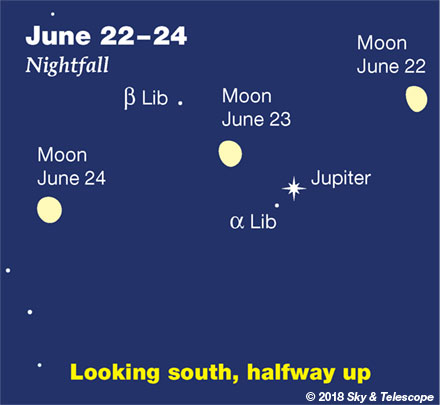
Friday, June 22
• The waxing gibbous Moon this evening shines with bright Jupiter to its lower left and fainter Spica to its lower right.
Saturday, June 23
• The bright "star" with the Moon tonight is Jupiter. Although they look rather close together, Jupiter is currently 1,800 times farther away — and it's 40 times larger in diameter.
• This is the time of year when the two brightest stars of summer, Arcturus and Vega, are about equally high overhead soon after dark: Arcturus toward the southwest, Vega toward the east.
Arcturus and Vega are 37 and 25 light-years away, respectively. They represent the two commonest types of naked-eye stars: a yellow-orange K giant and a white A main-sequence star. They're 150 and 50 times brighter than the Sun, respectively — which, combined with their nearness, is why they dominate the evening sky.
________________________
Want to become a better astronomer? Learn your way around the constellations! They're the key to locating everything fainter and deeper to hunt with binoculars or a telescope.
This is an outdoor nature hobby. For an easy-to-use constellation guide covering the whole evening sky, use the big monthly map in the center of each issue of Sky & Telescope, the essential guide to astronomy.

Once you get a telescope, to put it to good use you'll need a detailed, large-scale sky atlas (set of charts). The basic standard is the Pocket Sky Atlas (in either the original or Jumbo Edition), which shows stars to magnitude 7.6.
Next up is the larger and deeper Sky Atlas 2000.0, plotting stars to magnitude 8.5; nearly three times as many. The next up, once you know your way around, is the even larger Uranometria 2000.0 (stars to magnitude 9.75). And read how to use sky charts with a telescope.
You'll also want a good deep-sky guidebook, such as Sue French's Deep-Sky Wonders collection (which includes its own charts), Sky Atlas 2000.0 Companion by Strong and Sinnott, or the bigger Night Sky Observer's Guide by Kepple and Sanner.
Can a computerized telescope replace charts? Not for beginners, I don't think, and not on mounts and tripods that are less than top-quality mechanically (meaning heavy and expensive). And as Terence Dickinson and Alan Dyer say in their Backyard Astronomer's Guide, "A full appreciation of the universe cannot come without developing the skills to find things in the sky and understanding how the sky works. This knowledge comes only by spending time under the stars with star maps in hand."
This Week's Planet Roundup
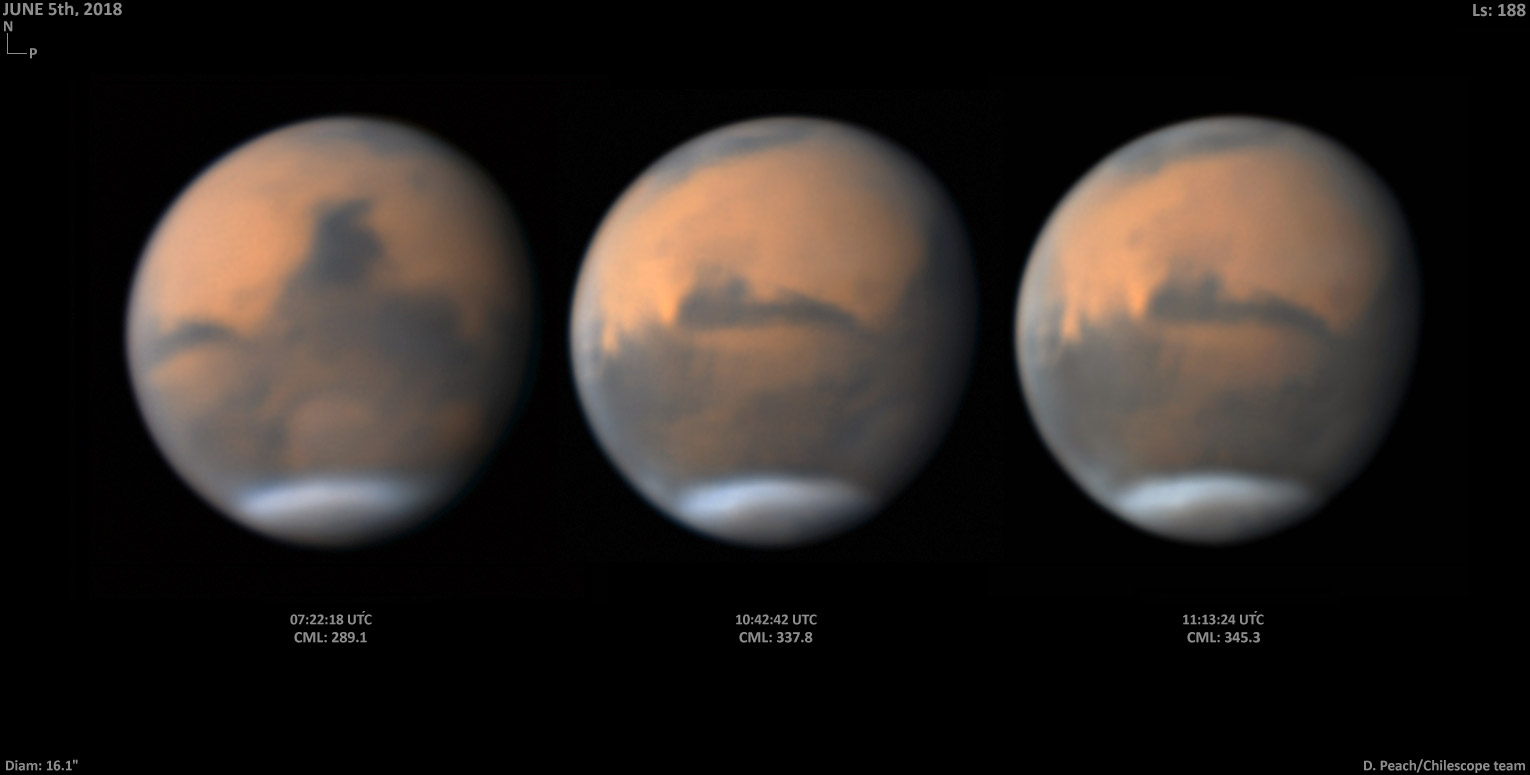
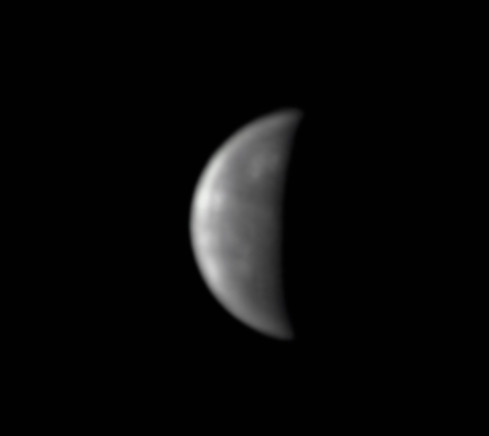
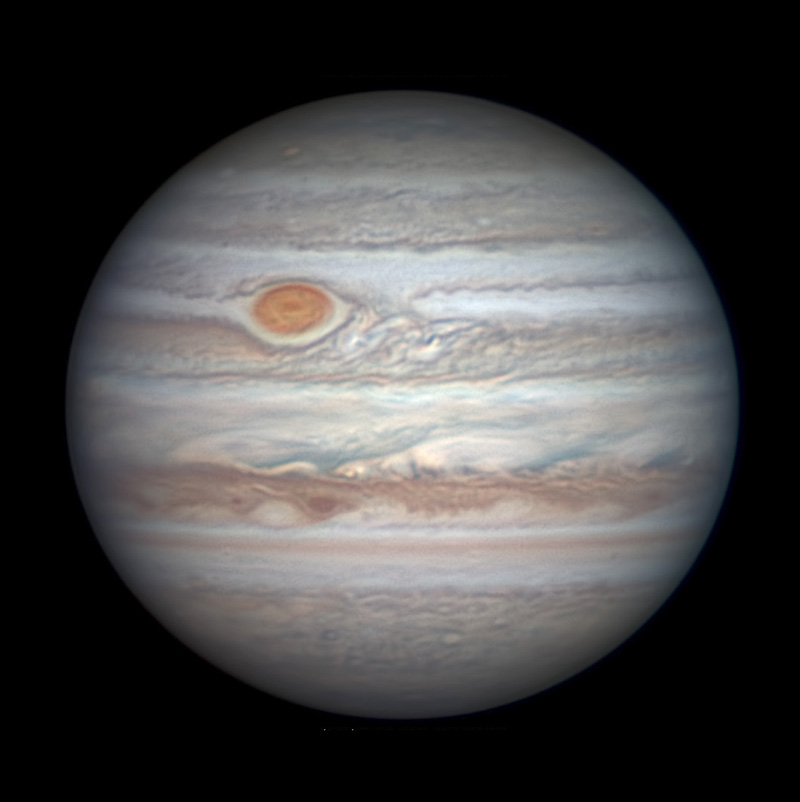
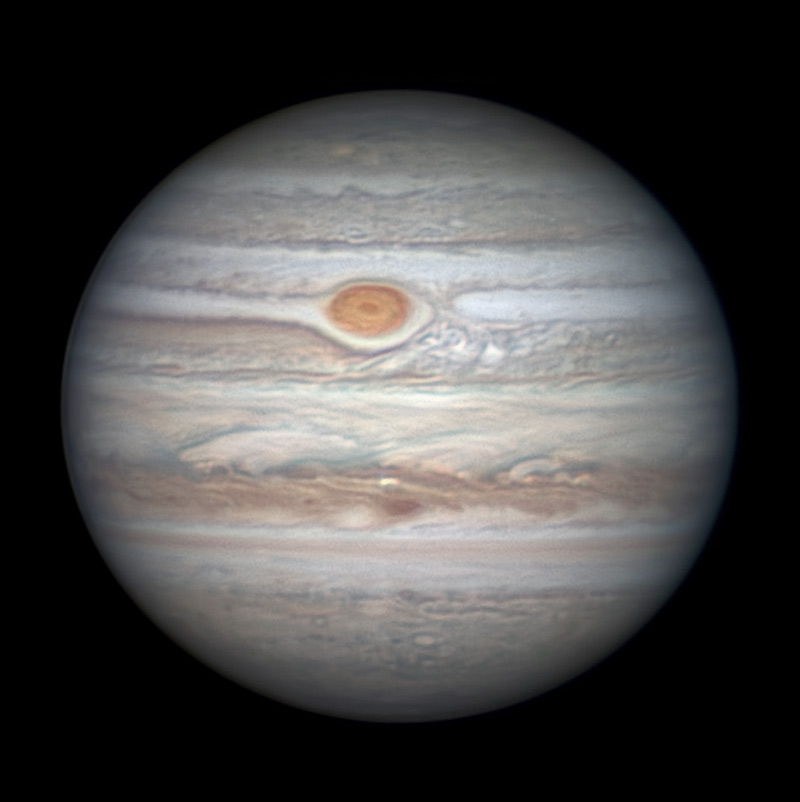
Mercury (magnitude –1 to –0.5) is rapidly becoming more easily visible in evening twilight, very far to the lower right of Venus. Catch it in the narrow time window between when the sky is still too bright and when Mercury sinks too low and sets.
Venus (magnitude –4.0, in Cancer) shines brightly in the west-northwest during twilight and just after. Look for Pollux and Castor increasingly far to its lower right, and Regulus increasingly less distant off to its upper left. In a telescope Venus is still a small gibbous disk.
Mars (magnitude –1.8, in Capricornus) rises around 11 or midnight daylight-saving time. Watch for it to come up about 30° lower left of Saturn. Mars is highest in the south, in best view for telescopes, just before dawn.
Mars is enlarging and brightening rapidly on its way to an unusually close opposition at the end of July. It's now 18 to 19 arcseconds wide — bigger than at many of its oppositions! — and gibbous. It will grow to 24.3 arcseconds for the week around its closest approach on the night of July 30–31.
The great dust storm that began on Mars at the end of May and has now spread across most of one side of the planet, obscuring many familiar features with bright yellow clouds. See our article Big Dust Storm Blows up on Mars (updated). NASA press release (June 20).
See also our telescopic guide to Mars in the July Sky & Telescope, page 22. You'll also want a Mars map that shows which features are facing Earth at your time and date, such as our Mars Profiler online.
Vesta, the brightest asteroid, is also unusually bright and close. This week it's at its very brightest, magnitude 5.3. Opposition is June 19th. It's in the Sagittarius Milky Way west of Saturn, heading toward Ophiuchus. Article and finder charts: Vesta Gets Close and Bright.
Jupiter (magnitude –2.5, in Libra) shines in the south as twilight fades. It's still 43 arcseconds in equatorial diameter. See our telescopic guide to observing Jupiter in the May Sky & Telescope, page 48.
Saturn (magnitude +0.1, just above the Sagittarius Teapot) rises in the southeast in twilight. It stands highest in the south around 1 or 2 a.m., about 30° to the upper right of much brighter Mars.
Uranus is still fairly low in the east before the first light of dawn.
Neptune (magnitude 7.9, in Aquarius) is well up in the southeast just before the beginning of dawn. Finder charts for Uranus and Neptune.
______________________
All descriptions that relate to your horizon — including the words up, down, right, and left — are written for the world's mid-northern latitudes. Descriptions that also depend on longitude (mainly Moon positions) are for North America.
Eastern Daylight Time (EDT) is Universal Time (also called UT, UTC, GMT, or Z time) minus 4 hours.
______________________
"Remember to look up at the stars and not down at your feet. Try to make sense of what you see and wonder about what makes the universe exist. Be curious."
— Stephen Hawking, 1942–2018
______________________
"The dangers of not thinking clearly are much greater now than ever before. It's not that there's something new in our way of thinking, it's that credulous and confused thinking can be much more lethal in ways it was never before."
— Carl Sagan, 1996
______________________
"Objective reality exists. Facts are often determinable. Vaccines save lives. Carbon dioxide warms the globe. Bacteria evolve to thwart antibiotics, because evolution. Science and reason are not a political conspiracy. They are how we determine facts. Civilization's survival depends on our ability, and willingness, to do so."
— Alan MacRobert, your Sky at a Glance editor
______________________
"Facts are stubborn things."
— John Adams, 1770
 0
0








Comments
You must be logged in to post a comment.